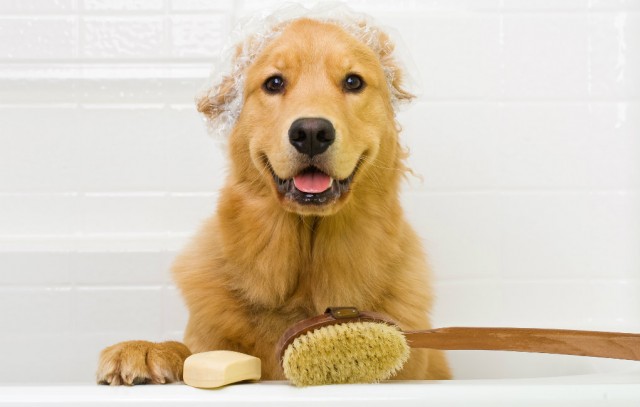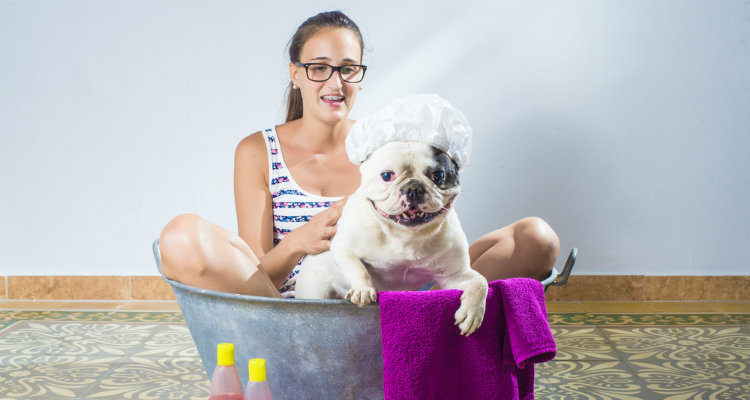
Table of Contents
- How to Get Your Dog to Love Bathing
- Be gentle but firm
- Bribe your dog with treats
- Bribe him with toys
- Praise definitely helps
- Post-bath party
- Teach a puppy before he’s twelve weeks old
- Make bath time therapeutic for an elderly or disabled dog
- Make it obvious you’re having fun
- Why does your dog continue to act afraid or irritated?
- Relax your dog beforehand by brushing him
- Has your dog done everything he needs to do?
Bath time! Just the phrase can strike fear in the heart of a pet owner. However, grooming and bathing your dog is part of your responsibility and can actually be super fun if your dog is cooperative.
Unfortunately, our dogs are not always on the same page as we are and they can prove to be really difficult at bath time.
Products like grooming wipes and waterless shampoo are great for those times when you only need to clean a small area of your dog, or when he isn't all that dirty.
You shouldn't use these products all the time, though.
Your dog needs to have a traditional bath with soap and water at least once for every three times that you bathe him with waterless shampoo.
Nothing beats a traditional bath. The dog shampoo and water get deep down into your dog's coat to clean his fur and his skin.
It strips all the built up dirt, oils, and grime from your pet's coat and leaves it shinier and healthier.
Although waterless shampoo is great, it still isn't as good as a traditional bath.
Baths may be good for dogs, but dogs don’t understand the concept of “best interest” when it comes to making them do something they don’t want to do.
To make bath time more pleasant and less stressful, consider the following tips for making your dog love his bath.
RELATED: How to Make Bathing a Dog Easier (And Some Unique Tools You Can Use)
How to Get Your Dog to Love Bathing
Be gentle but firm
First and foremost, be gentle but firm with your dog at bath time.
Let him know that you're the boss and that this is going to happen, but don't get involved in a wrestling match with him. Either or both of you could get hurt. (You may have to use grooming restraints to keep him in place.)
Just remain calm, speak soothingly, and if you have to, stop the bath until he's calmer and then start again slowly.
RELATED: Dog Bathing Tips: How to Give a Dog a Bath
Bribe your dog with treats
When it comes to being a political candidate, bribery is not a good idea.
However, when you’re a pet owner trying to get your dog to chill out at bath time, it can be a lifesaver.
If your dog doesn’t like the idea of getting in the tub, use a dog treat to entice him.
Hold the treat above the middle of the bathtub so that he has to get close to the water.
Keep moving it farther and farther away so eventually he has to get in the bathtub to get it.
Treats will put him in a better mood and help him associate bath time with treat time. However, your dog might be conning you.
Don’t always give him a treat when he starts acting up; otherwise, he’ll behave badly on purpose because you’ve rewarded him for misbehaving.
[optin-monster-shortcode id=”mmevqhqfl46p1is5″]
Bribe him with toys
If your dog likes toys, they’re another useful way to bribe him. Get a dog toy that squeaks and is waterproof and toss it in his bath. Your dog will be so happy to play with his toy that he’ll forget that he’s stubbornly refusing to get in the tub.
Praise definitely helps
Praise your dog as well. Dogs like to be told how awesome they are in that special tone of voice you use, and it’s hard to stay mad at someone who’s complimenting you.
Also, he associates the sound of your voice with security and protection, and that should calm him down too.
Post-bath party
Post-bath, have a “party.” Once you’re done with your dog’s bath time, do something he really likes such as playing tug of war.
Your dog will connect bath time with fun time, and he’ll become happier about taking a bath.
RELATED: How to Get Your Dog to Love Bathing
Teach a puppy before he’s twelve weeks old
If you have a puppy, start as early as possible teaching him that bath time is fun.
Between three and twelve weeks, puppies are very open to new experiences. A calm, soothing bath in a quiet environment can be very pleasant for him.
Puppies tend to be wild, so make sure bath time is in a calm environment without distractions so he doesn't get overexcited and overstimulated.
Remember, though, that puppies can’t control their temperature very well. Make sure he doesn’t get cold.
Make bath time therapeutic for an elderly or disabled dog
If you have an elderly or disabled dog, he might not be too keen on taking a bath because of joint pain or just generalized stiffness.
If that’s the case, make bath time therapeutic. Use warm water but make sure it’s not too hot.
Dogs have more sensitive skin than we do, and water that’s too hot will hurt them.
Turn bath time into massage therapy so your elderly dog won’t associate pain with a bath.
In fact, he’ll begin to look forward to a bath as a way to relax and ease some of the joint pain and stiffness. Warm water and a gentle massage do wonders for aching joints.
Make it obvious you’re having fun
Make sure your dog knows that you’re having fun. Don’t make it a do-or-die scenario. Act excited about bath time.
Sometimes dogs pick up on our emotions because we’re the closest people to them.
If you're impatient and act like you dread bath time too, your dog will view it in the same negative way.
Why does your dog continue to act afraid or irritated?
If your dog is showing apprehension at bath time, find out why. Observe his behavior. Could it be that he doesn’t like water? Is the water too warm or too cold?
There could be a concrete reason why he's hesitant about bath time that when corrected, clears the way for your dog to love it.
RELATED: 2015 Top 5 Best Grooming Tables
Relax your dog beforehand by brushing him
Another way to encourage your dog to love baths is to relax him beforehand. Brushing your dog before a bath is very important; don’t forget to do it.
It helps remove mats and tangles before they become even more difficult to get out. But brushing also has a secondary purpose.
It’s the first step of grooming and can set the tone for bath time. Keep your dog calm during brushing by petting him, talking soothingly, and giving him the occasional treat.
Then, when you put him in the tub, he’s already enjoying himself.
If you plop him in there unceremoniously after a rushed, rough brushing, you’re likely to have a bad time.
Has your dog done everything he needs to do?
Our last tip is to make sure that all of your dog's needs are met before you start the bath.
Make sure that he has used the bathroom, eaten, and in general completed his normal needs.
Then your dog won’t be distracted or nervous during grooming. His full attention can be focused on bath time and enjoying himself.
Bath time doesn’t have to be frustrating drudgery. It can be loads of fun when you do it right and know how to make sure your dog isn’t nervous or anxious.
Start bathing your dog as early as possible so that he gets used to it, which makes your job easier. And don’t forget to have fun!














